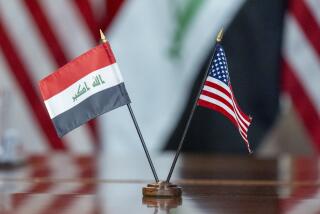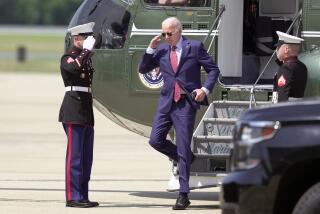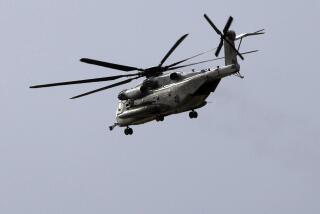Skirmish Leaves Two Pendleton Marines Missing
DHAHRAN, Saudi Arabia — U.S. forces have engaged in minor skirmishes with Iraqi troops on the Kuwaiti border, prompting U.S. air strikes that reportedly killed at least 40 Iraqis and left two Camp Pendleton Marines missing in action.
The Defense Department identified the missing fliers as Lt. Col. Clifford Acree, 39, and Chief Warrant Officer Guy Hunter, 46, the crew of a Marine OV-10 Bronco turboprop plane that was directing fire against Iraqi artillery positions in Kuwait.
They are the first soldiers from the West Coast to be listed as casualties.
Reports from Marine units deployed near the Saudi-Kuwaiti border city of Khafji indicate Iraq’s most sustained counterattack so far. And they indicate movement by the U.S. forces to engage the enemy along the border in possible preparation for a ground assault into Kuwait.
Though apparently very minor, the skirmishes represent the first known ground combat between Iraqi troops and the large coalition of allied forces poised to move into Kuwait.
Commanders in the field said the aerial attacks were intended primarily to take out artillery positions that have shelled Marine units sporadically the last three nights. They were conducted by Air Force A-10 Thunderbolt tank fighters and by AV-8 Harrier jump jets from the 3rd Marine Air Wing, with headquarters at El Toro Marine Corps Air Station. They used 500- and 1,000-pound bombs and Rockeye cluster bombs.
But most pilots returning from missions into Kuwait said they were also clearly directing their weapons at Iraqi troops.
“We’re out there to kill,” said A-10 pilot Capt. Eric Salomson, who was attacking Iraqi tanks lined up in defensive earth mounds across the Kuwaiti border. “The only way we’re going to beat these guys is to keep all the jets flying all the time. I don’t have a lot of hate for these guys, because I think they have bayonets in their backs. But . . . our job is to reap terror out there.”
Pentagon officials have primarily discussed operations against Iraq’s elite Republican Guards, the backbone of Iraq’s huge military machine, deployed south of the Iraqi port city of Basra and in northern Kuwait.
“We’re trying to hammer them just as hard as we can,” Lt. Gen. Thomas W. Kelly, director of operations for the Joint Chiefs of Staff, said at the Pentagon.
Four British-designed Harriers on Saturday destroyed an Iraqi communications center about 20 miles north of the Kuwaiti border, a facility that U.S. officials believe communicated instructions to Iraqi field commanders and directed the artillery fire that injured two Marines assigned to the 1st Marine Expeditionary Force near Khafji, as well as a Navy hospital corpsman.
Most of the Iraqi rockets lobbed across the border, at the rate of three to four per night, have exploded harmlessly in the desert near Saudi positions, Marine supply depots and other support units, including a field hospital, that have been deployed north near the border in preparation for a ground assault.
Some of the incoming assaults have been tentatively identified as FROG short-range missiles, and troops have taken precautions against chemical weapons. No chemicals have been used so far, however. One rocket fell about 2,000 yards away from a supply depot and left a 20-foot crater in the sand.
An oil storage tank belonging to the Arabian Oil Co., also hit in the bombardment, continued to burn Saturday. But no critical military facilities have been hit, U.S. officials said.
“Either they’re really bad shots, or they have no idea where everything is,” Marine Lt. Jim Tuemler said Saturday. “They’ve been very inaccurate if they’re aiming at us.”
However, the sporadic attacks mean frequent trips to the bunker and frantic donning of chemical weapons protection gear, and that has kept the Marines camped out at the border tense and sleepless.
“The young ones, the old ones, they all get nervous when you start jumping into the bunkers,” Lt. Barney Barendse said.
A report filed by combat pool reporters said retaliatory strikes by U.S. aircraft into southern Kuwait have killed about 40 Iraqi soldiers.
“We’re trying to eliminate any target up there that has any potential of moving south,” said one pilot, Marine Capt. Trey Wilbourn. “From the beginning, there has been constant, round-the-clock bombardment of ground troops.”
“We’re not getting as much resistance as we thought we would,” added Maj. Randy Powell. “I don’t know if they don’t have it, or if they’re holding it back.”
The allied ground forces have been steadily increasing their presence in Saudi Arabia’s northern desert. As the air bombardment of Iraq and Kuwait began, a long line of M1-A1 tanks and Bradley Fighting Vehicles moved up from the south and took positions south of the Kuwaiti border, churning up clouds of dust that could be seen for miles.
On Saturday, the 2nd Brigade of the 82nd Airborne Division, a crucial part of the U.S. Army’s rapid deployment force, began ferrying artillery, 105-millimeter howitzers, shoulder-fired missiles and mortars northward toward the border.
The move north was expected to take several days, probably continuing as the air war progresses over Iraq and Kuwait.
“We’re repositioning in an assembly area north along the border to conduct offensive operations if we’re told,” said the brigade’s commander, Col. Ron Rokos. “The pregame show is over.”
Times staff writers Nora Zamichow and Mark Platte contributed to this report.
More to Read
Sign up for Essential California
The most important California stories and recommendations in your inbox every morning.
You may occasionally receive promotional content from the Los Angeles Times.










